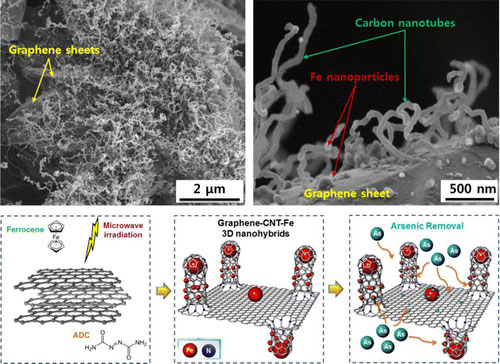| Sep 11, 2013 |
Removing arsenic from water with 3D graphene based nanostructures
|
|
(Nanowerk News) Arsenic contamination of groundwater is a critical problem that affects millions of people across the world and results in severe diseases such as skin or lung cancer and bladder cancer
|
|
Researchers in Korea now report a fast and facile microwave method to synthesize novel graphene-carbon nanotube-iron oxide (G-CNT-Fe) 3D functional nanostructures consisting of carbon nanotubes vertically standing on graphene sheets and iron oxide nanoparticles well distributed on both carbon nanostructures ("Arsenic Removal from Contaminated Water Using Three-Dimensional Graphene-Carbon Nanotube-Iron Oxide Nanostructures").
|
|
The unique 3D nanostructure shows that carbon nanotubes are vertically standing on graphene sheets. The material shows excellent absorption for arsenic removal from contaminated water, due to its high surface-to-volume ratio and open pore network of the graphene-carbon nanotube-iron oxide three-dimensional nanostructures.
|
 |
|
The iron oxide nanoparticles are not only magnetically active but can also provide a great functionality in the arsenic removal from contaminated water. This unique 3D nanostructure greatly absorbs arsenics from contaminated groundwater because of increased surface-to-volume ratio, protected agglomeration. and water pathway of 3D nanostructures.
|
|
The fact that these results were achieved by simple microwave radiation and in single step with high yields makes this technique attractive for large scale synthesis of these unique 3D nanostructures.
|

